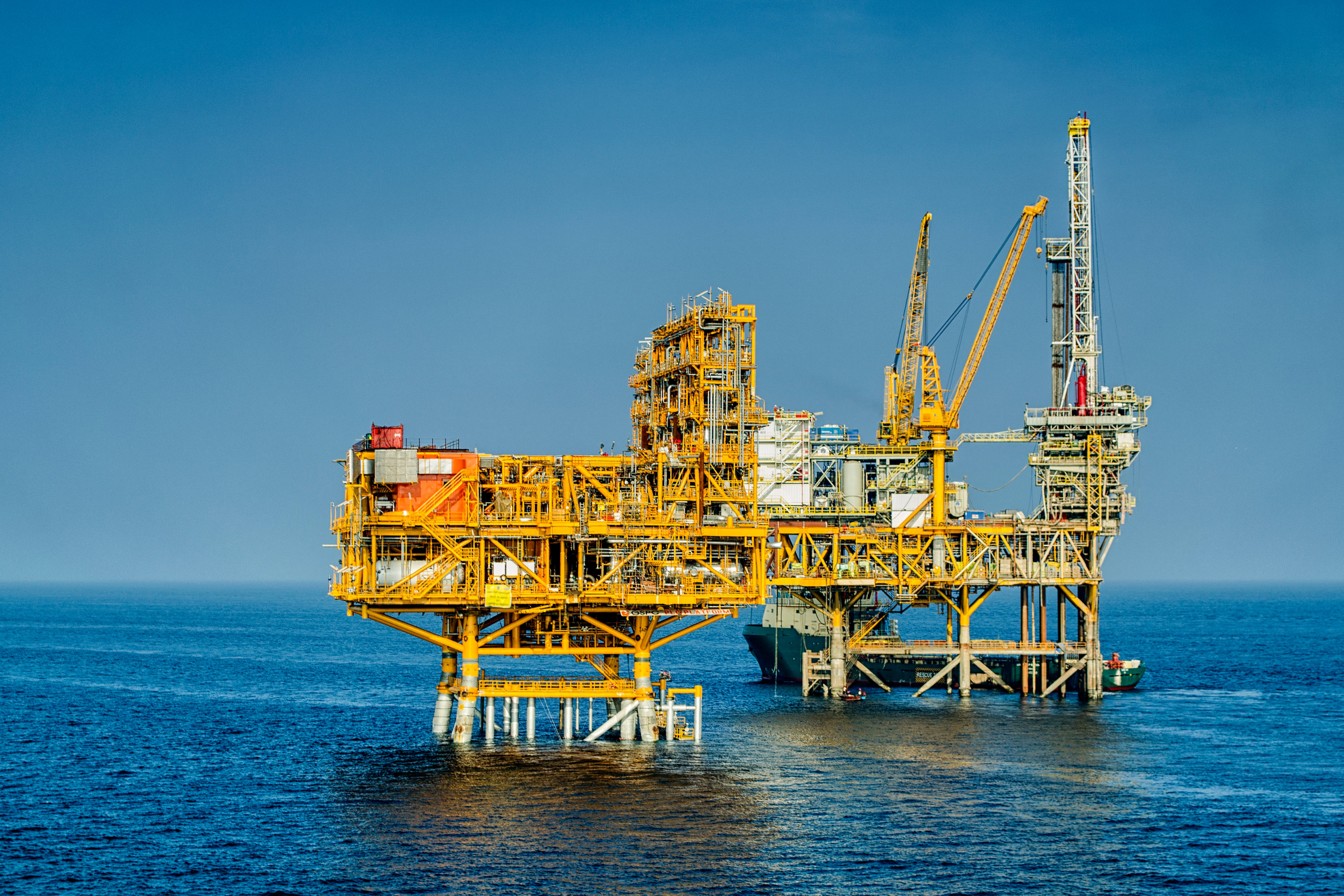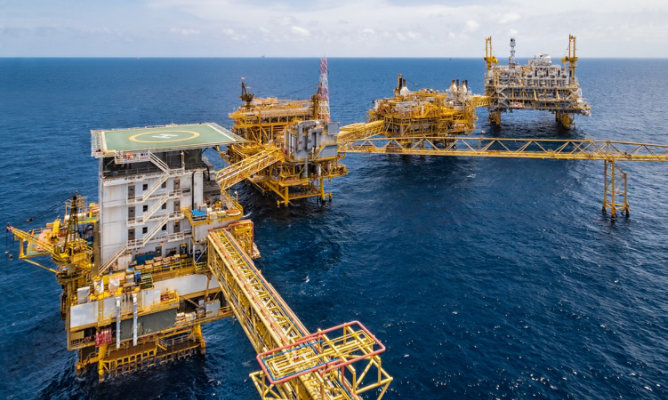
Getting Ahead of Corrosion Offshore
Data from new testing protocol will help energy producers choose better-performing coatings for offshore platforms.
Find this article on page 12 of our new custom publication, Market Pulse - Advancements in Coatings Technology, featuring industry trends and thought leadership.
By Bruce Toews, Global Market Director – Oil & Gas, and Johnny C. Pourciau, Oil & Gas Market Director – United States, Canada and the Caribbean
Major petroleum industry stakeholders who own, operate and maintain drilling and production facilities in the Gulf of Mexico, North Sea and other offshore environments face ongoing corrosion challenges. The ocean’s high saltwater content, as well as extreme atmospheric and underwater temperatures, prove hostile to platforms and topside equipment, placing stresses on the coating systems that protect steel structures above, around and below the splash zone. The constant need for corrosion prevention and mitigation makes these structures expensive to maintain.
While the corrosion precipitated by harsh sea environments is well understood, owners and operators of offshore platform equipment feel fortunate if the protective coatings on their equipment last for four to six years. Very often, however, oil and natural gas producers report that the coatings used in upstream applications are lasting only 18 to 24 months before maintenance crews must make major repairs, including blasting and recoating the steel to restore protection. These interruptions are costly and inefficient because they often slow down production rates. In addition, platform accommodations are at a premium, leaving minimal opportunities to house coating applicators onboard to perform maintenance.
To help stakeholders across the upstream, midstream and downstream oil and gas industries achieve longer service lives for their assets, Sherwin-Williams Protective & Marine began rethinking how to approach corrosion mitigation for these operating environments. Many industry players are still promoting older systems, but stakeholders in the oil and gas industries desire innovative systems that will drive operational efficiency and excellence.
To meet customers’ needs to extend the lifecycle and reduce the downtime of their offshore assets, Sherwin-Williams developed an accelerated testing protocol for predicting the performance of various coating systems. The findings are revealing some surprising results that suggest the industry should consider adopting new specification strategies.
Entering the third year of the testing and data collection, results are revealing new technology drivers that enable the improved life cycle performance of various coatings.
Complete Testing with Varied Surface Preparations
The types of coatings selected for the test procedure represented both “typical” and “atypical” systems for atmospheric service. The study also included a variety of substrate profiles to duplicate the angles found on offshore assets and ensure any areas vulnerable to corrosion were thoroughly examined.
To begin the procedure, lab technicians applied 11 coating systems to test panels featuring different surface preparations. Surface preparation methods included: grit blasting (according to SSPC-SP10) on one set of panels; grit blasting contaminated with 25 µg/cm2 Cl- on another set; ultra-high pressure water jetting (according to NACE No. 5 WJ-2/Moderate Flash Rust) on a different set; and a power tool treatment (according to SSPC-SP11) before being contaminated with 25 µg/cm2 Cl- on the last set.
Lab technicians prepared the panels (according to SSPC-SP10) contaminated to 25 µg/cm2 Cl- by uniformly spraying them with a known volume of an aqueous solution. The panels were then flash rusted to a moderate grade (as described in NACE No. 5). The concentration of chlorides on the contaminated panels was verified to be 24 µg/cm2, based on a commercial, soluble salt testing kit.
The panels that received ultra-high pressure water-jetting were left to rust in a light industrial environment for 30 days (according to an SSPC VIS-3 Condition C), after which technicians performed ultra-high pressure water-jetting (based on NACE No. 5 WJ-2) with water at 30,000 psi. The panels were flash rusted to a moderate grade as described above before coating.
The panels that received the power tool treatment were prepared by rusting according to the above procedure. Then technicians used a power tool to obtain a surface preparation (according to SSPC-SP11), following that up by spraying a salt solution on the panel, which once again resulted in moderate flash rust.
True-to-Life Exposure Conditions Mimic Offshore Stresses
Each set of test panels was exposed to the following four conditions:
a) NACE TM0304 (i.e., cyclic weathering according to a modified ASTM D5894-16 exposure), in which the electrolyte was synthetic seawater
b) Exterior exposure at a 30° angle facing the ocean in a warm environment
c) Exterior exposure at a 45° angle facing south in a light industrial environment
d) Exterior exposure at a 30° angle facing the ocean in a cold environment
Lab technicians then subjected each of the coatings to four types of analyses. First, a visual analysis of the exterior helped to determine evidence of damage or corrosion, undercutting and degradation of color or gloss. This analysis also looked at surface edges for blistering, rusting, scribe creepage or signs of any visible breakdown. Second, technicians tested the coatings using electrochemical impedance spectroscopy. Third, they evaluated the permeability of the coatings before and after the test panels were exposed according to the above conditions. Finally, the lab tested the panels using Fourier Transform Infrared Spectroscopy before and after they were exposed to the simulated weather and temperature conditions above to analyze the coatings’ chemical properties and evaluate their health.
When the results of this testing protocol are finalized in 2020, owners and operators of oil platforms, as well as companies that transport, store, refine and distribute oil and gas, will have a clearer picture as to what systems offer the lowest corrosion potential and longest maintenance intervals.
A Top Performer Emerges
Following 24 months of the 36-month test protocol, Sherwin-Williams has already determined there are greater benefits in specifying select one- and two-coat systems compared to the traditional three-coat systems used. At this advanced stage of the study, the application of Corothane® I – GalvaPac 1K Zinc Primer, an organic zinc-rich, moisture-cured urethane primer from Sherwin-Williams, has shown the best results to date. This and other zinc-rich primer systems are demonstrating superior corrosion resistance and have exhibited no major breakdown after 24 months into the test procedure.
Second, testing determined that a coating system’s film thickness only helps prevent corrosion in offshore applications if it is extremely high. Moreover, testing also showed that a thin film of high ultraviolet-resistant fluoropolymer impedes corrosion within these contexts.
When the results of this testing protocol are finalized in 2020, owners and operators of oil platforms, as well as companies that transport, store, refine and distribute oil and gas, will have a clearer picture as to what systems offer the lowest corrosion potential and longest maintenance intervals. In addition, the new test method results should benefit contractors involved in maintenance, as well as fabricators and engineering firms.
For decades the key goal in the Sherwin-Williams Protective & Marine division has been to build new systems that promote longevity in all segments of the oil and gas industry by mitigating corrosion through the strategic selection of protective coatings. This new testing protocol is an example of the company’s commitment to drive new coating technologies, systems and products that enable better coatings specifications, corrosion protection and outcomes.
Discover More
Industry Expertise and Innovation
See how we help customers find customized solutions for their project and application challenges.
Our Oil & Gas Expertise
Explore our industry solutions and technology to help protect your assets.
LEARN MOREProduct Lookup
Find out more about our innovative coatings for a variety of industries.
FIND A PRODUCT
